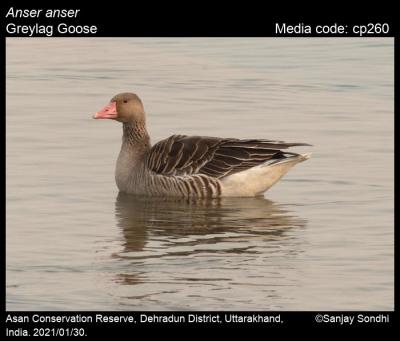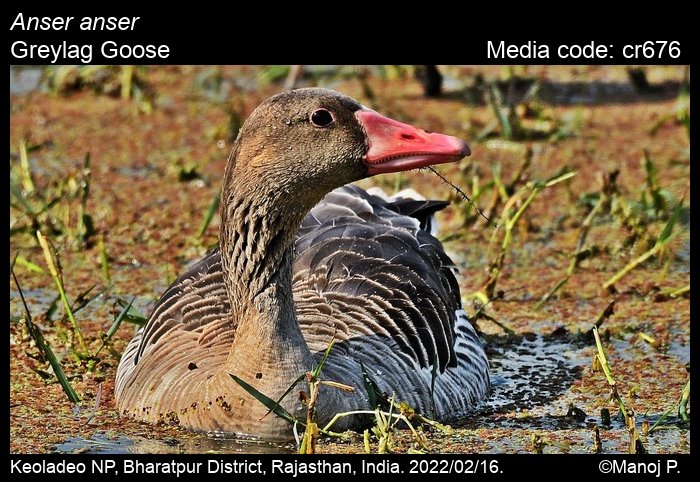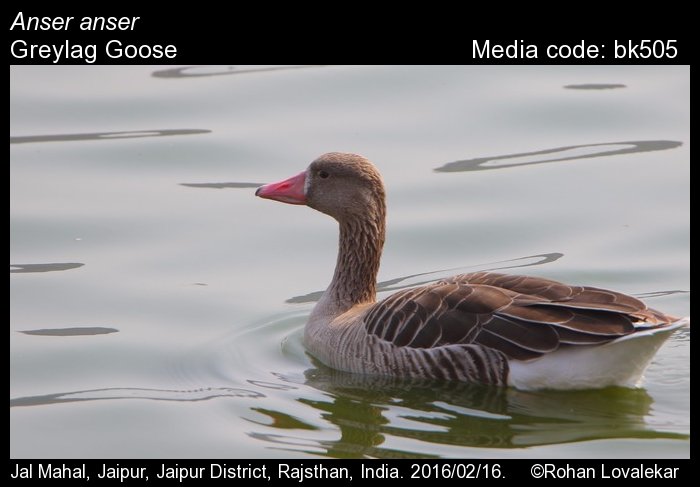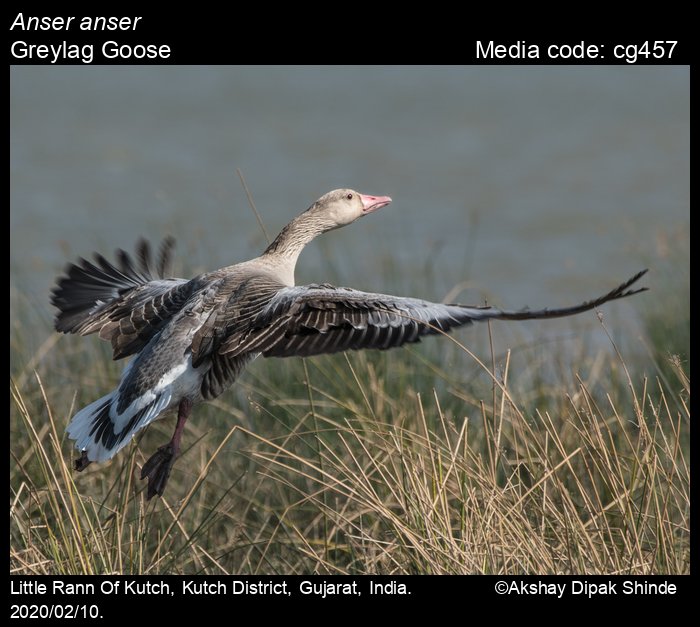
Subspecies in India
Photo Gallery and Species Biology
Breeding Season: May to June. Extralimital (Central Asia, Europe).
Nest: Nests made of twigs and grasses on ground near the marshes, lakes and coastal islands.
Eggs: 3-5 eggs in a clutch.
Size: length: 81 cm. wingspan: 147 to 180 cm.
Distinguishing Characters:
Adults: It is a large ashy-brown coloured goose with pink legs and beak, white nails and whitish margins to feathers of upperparts, flight feathers and flanks. Show frekles on the upper neck.
Young/Immatures: Similar to adults, with pale beak and feet.
Similar Species in India:
(1) Greater white-fronted Goose (differs from Greylag by having broad white band in the front of the head i.e. at all the sides of base of beak, black barrings on belly and yellow legs).
(2) Lesser White-fronted Goose (differs from Greylag by having white band at the front of the head, distinct yellow-eye ring, yellow legs and smaller size).
(3) Bean Goose (differs from Greylag by having overall darker grey plumage, black beak with small yellow band, and yellow legs). This species is vagrant in India.
(4) Domestic Goose (Anser anser domesticus) is domesticated variety of Greylag goose which appears in variable colouration that may range from uniform brown to uniform grey, but lacks pink legs and beak.
It is gregarious species that aggragates in the large flocks, often found along with Bar-headed Geese, Greater and Lesser -white fronted geese. Usually active early in the day, resting during afternoon and active again by evening.
Foraging Behaviour: Diet is largely herbivorous, feeding on grasses and sometimes feeding on small crustaceans, amphibians, molluscs and fishes.
Call/Song: Loud, harsh nasal honking gag-gag-gag or aang-aang-gag-ung-ung
Migration Status: Strongly Migratory, migrating in India mainly in the northern regions.
IUCN Status: Least Concern.
| State | Jan | Feb | Mar | Apr | May | Jun | Jul | Aug | Sep | Oct | Nov | Dec | No date |
|---|---|---|---|---|---|---|---|---|---|---|---|---|---|
| Andaman and Nicobar Islands | |||||||||||||
| Andhra Pradesh | |||||||||||||
| Arunachal Pradesh | |||||||||||||
| Assam | 1 | 1 | |||||||||||
| Bihar | |||||||||||||
| Chandigarh | |||||||||||||
| Chhattisgarh | |||||||||||||
| Dadra & Nagar Haveli | |||||||||||||
| Daman & Diu | |||||||||||||
| Delhi | |||||||||||||
| Goa | |||||||||||||
| Gujarat | 2 | ||||||||||||
| Haryana | |||||||||||||
| Himachal Pradesh | |||||||||||||
| Jammu and Kashmir | |||||||||||||
| Jharkhand | |||||||||||||
| Karnataka | |||||||||||||
| Kerala | |||||||||||||
| Lakshadweep | |||||||||||||
| Madhya Pradesh | |||||||||||||
| Maharashtra | |||||||||||||
| Manipur | |||||||||||||
| Meghalaya | |||||||||||||
| Mizoram | |||||||||||||
| Nagaland | |||||||||||||
| Odisha | |||||||||||||
| Paschimbanga | |||||||||||||
| Pondicherry | |||||||||||||
| Punjab | |||||||||||||
| Rajasthan | 3 | 2 | |||||||||||
| Sikkim | |||||||||||||
| Tamil Nadu | |||||||||||||
| Tripura | |||||||||||||
| Uttar Pradesh | 1 | ||||||||||||
| Uttarakhand | 2 | ||||||||||||
| West Bengal | |||||||||||||
| Total | 5 | 5 | 2 |
1. Rasmussen, P. C., and J. C. Anderton. 2005. Birds of South Asia: The Ripley Guide. Washington, DC.
2. Ali, S., and S. D. Ripley. 1978. Handbook of the Birds of India and Pakistan: Together with those of Nepal, Sikkim, Bhutan and Ceylon (Vol. 1). Oxford University Press.
3. Stuart Baker, E. C. 1933. The Nidification of Birds of the Indian Empire. Taylor And Francis.
Page citation
Anonymous 2024. Anser anser (Linnaeus, 1758) – Greylag Goose. In Satose, V., A. Bayani, V. Ramachandran, P. Roy, and K. Kunte (Chief Editors). Butterflies of India, v. 2.17. Published by the Indian Foundation for Butterflies. URL: https://www.birdsofindia.org/anser-anser, accessed 2024/05/05.

























